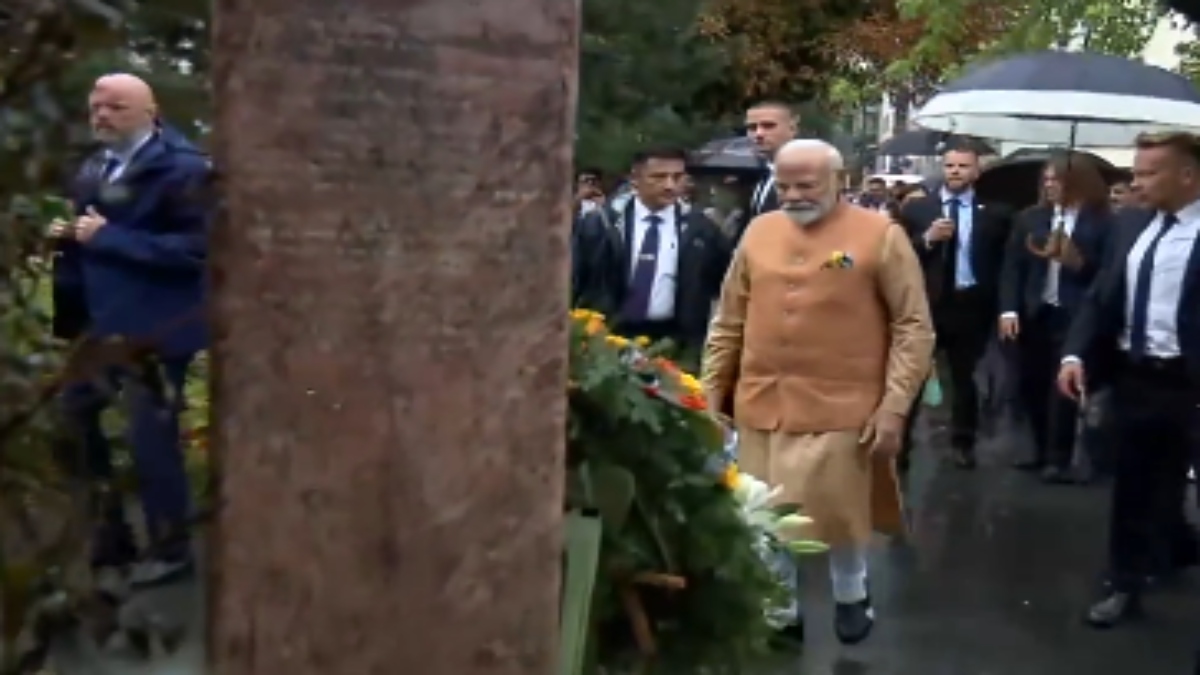Shortly after he was accorded a warm welcome by the members of Indian diaspora at a Warsaw hotel, Prime Minister Narendra Modi soon left to visit Jam Saheb of Nawanagar Memorial where he laid a wreath, making him the first Prime Minister to pay his respects at the Warsaw memorial.
#WATCH | Prime Minister Narendra Modi lays a wreath at Jam Saheb of Nawanagar Memorial in Warsaw, Poland
— ANI (@ANI) August 21, 2024
PM Modi is on a two-day official visit to Poland. pic.twitter.com/B1GorViHBH
#WATCH | Prime Minister Narendra Modi visited Jam Saheb of Nawanagar Memorial in Warsaw, Poland
— ANI (@ANI) August 21, 2024
He also laid a wreath here. pic.twitter.com/Ez4kXdcf21
The Prime Minister also laid a wreath at Monte Cassino Memorial and later visited the Kolhapur Memorial in Warsaw.
#WATCH | Prime Minister Narendra Modi lays a wreath at the Monument to Battle of Monte Cassino, in Warsaw, during his two-day official visit to Poland
— ANI (@ANI) August 21, 2024
The Battle of Monte Cassino was fought from May 11 to May 18, 1944, in World War II. The Polish forces suffered significant… pic.twitter.com/W1G2V0vnXd
#WATCH | PM Narendra Modi lays wreath at Kolhapur Memorial in Warsaw, Poland
— ANI (@ANI) August 21, 2024
"Members of the Association of Polish in India from 1942 to 48 and myself, I wish you, the prime minister, much health and success in fulfilling the mission you undertook by visiting Poland and Europe.… pic.twitter.com/9zoZHIrX0w
“The history behind these memorials connects Poland and India in a very special way,” said Ministry of External Affairs spokesperson Randhir Jaiswal.
During the Second World War, Maharaja Jam Sahib of Nawanagar - which is now in Gujarat - not only saved the lives of several Jewish children by bringing them to India from Poland but also took care of them as a guardian. The Maharaja of Nawanagar opened his summer palace to displaced children.
Warsaw’s ‘Good Maharaja Square’ pays tribute to Jam Saheb Digvijaysinh.
A group of about 1,000 Polish children, who were lost and orphaned amid death and destruction caused by WWII, departed for India in 1942 from Siberia, where they had been shifted after the 1939 Soviet invasion of Poland.
The children were welcomed by their benefactor, the Jam Sahib, but only after a tortuous journey.
The ships carrying Polish refugees from the former Soviet Union, including a large number of children, were denied entry when they called on ports while sailing through Iran to Bombay (Mumbai), then under British colonial rule.
When the Maharaja, who was a member of the Imperial War Council, was made aware of the plight of the children in the gulags, he became concerned and established a camp in Balachadi, about 25 km (15 miles) from the capital city Jamnagar, for the Polish arrivals.
Monte Cassino Memorial commemorates the victory of the soldiers of the Second Polish Corps at the Battle of Monte Cassino during the Second World War in 1944. The Second Polish Corps conquered the hill and the monastery on it. More than 900 Polish soldiers were killed in this battle.
Kolhapur Memorial has been set up in memory of the village in Kolhapur that hosted the Polish children whom the Jam Saheb of Nawangar had granted refuge. The children were moved to Valivade in Kolhapur in 1945. Valivade was chosen due to its favourable climate, located about 500 km south of Mumbai.
It was expected to provide a better living environment compared to harsh conditions in other regions.
After Polish refugees departed this place, its significance was preserved via various memorials. There is a cemetery in Kolhapur, which was restored in 2014 and honours the Polish individuals who died while they were in India.
With inputs from agencies


)

)
)
)
)
)
)
)
)



